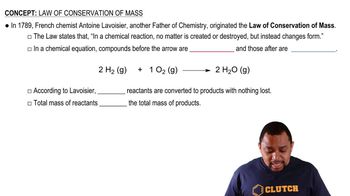Here are the essential concepts you must grasp in order to answer the question correctly.
Dalton's Atomic Theory
Dalton's atomic theory posits that matter is composed of indivisible atoms, which are the fundamental building blocks of all substances. Each element consists of identical atoms that differ from those of other elements. This theory laid the groundwork for understanding chemical reactions as rearrangements of atoms, rather than changes in the atoms themselves.
Recommended video:
Law of Mass Conservation
The law of mass conservation states that mass is neither created nor destroyed in a chemical reaction. This principle implies that the total mass of reactants must equal the total mass of products. Dalton's atomic theory supports this law by asserting that atoms are simply rearranged during reactions, ensuring that the same number of atoms (and thus mass) is present before and after the reaction.
Recommended video:
Law of Conservation of Mass
Law of Definite Proportions
The law of definite proportions states that a chemical compound always contains its component elements in fixed ratio by mass, regardless of the sample size or source. Dalton's atomic theory explains this by suggesting that compounds are formed from specific combinations of atoms in defined ratios, which leads to consistent proportions of elements in any given compound.
Recommended video:
Law of Definite Proportions
 Verified step by step guidance
Verified step by step guidance


